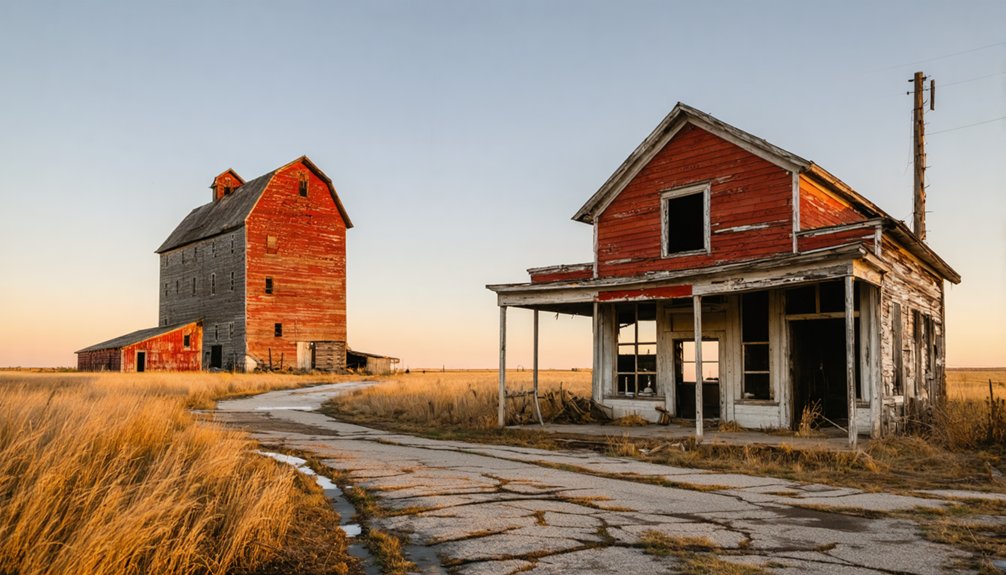You’ll find Englewood’s remains tucked away in South Dakota’s Black Hills, where it once thrived as a critical railroad hub during the 1890s gold rush. The Chicago, Burlington & Quincy Railroad transformed this settlement into a major transport center, with its engineering marvel at Seven Mile Bend descending 800 feet. Though little physical evidence remains today, the ghost town’s rich history of railroad workers, miners, and bustling commerce echoes through its abandoned grounds.
Key Takeaways
- Englewood originated during the 1874 Black Hills gold rush and later became a crucial railroad hub for the Chicago, Burlington & Quincy Railroad.
- The town’s economy centered around its railroad operations, featuring a roundhouse and depot that served mining camps and livestock transport.
- Railroad decline and shift to truck transportation in the early 20th century led to Englewood’s economic collapse and eventual abandonment.
- No standing structures remain at the site today, with the former town area likely consisting of empty fields and natural vegetation.
- Local legends include stories of ghostly railroad workers, phantom train sounds, and supernatural occurrences linked to the town’s mining past.
The Rise of a Black Hills Settlement
Long before Englewood emerged as a settlement, the Black Hills served as sacred ground for numerous Native American tribes, with the Lakota Sioux calling it *Pahá Sápa*.
This spiritual center, inhabited by humans since 11,500 BC, saw complex settlement dynamics as various tribes including the Arikara, Cheyenne, Crow, Kiowa, and Arapaho lived there before the Lakota’s arrival in the 1700s.
The discovery of gold in 1874 dramatically altered indigenous interactions when miners flooded the region, violating the Fort Laramie Treaties that had protected Native lands.
The 1874 gold rush shattered Native American sovereignty as waves of prospectors ignored treaties and invaded sacred Black Hills territory.
The government’s subsequent actions were deemed dishonorable by the Supreme Court in their dealings with the Sioux tribes.
Tensions escalated when Sioux chiefs refused to sell their sacred lands despite pressure from Washington.
You’ll find that early settlements quickly transformed into bustling boomtowns like Deadwood, Central City, and Lead.
These communities sprouted rudimentary infrastructure with boardwalk streets and timber buildings, though they struggled with lawlessness and a wild reputation.
Mining and Railroad Heritage
You’ll find Englewood’s origins deeply connected to the 1874 Black Hills gold rush, when prospectors moved north from Custer to stake claims in the area’s creek beds and Precambrian rock formations.
The Sioux Indians’ territory was permanently altered as prospectors ignored established treaties and flooded into the region. In the late 1870s, placer mining dominated the region’s early gold production, with Deadwood Gulch alone yielding about half of the $6-8 million extracted from local gravels. The nearby town of Lead became a major mining hub when the Homestake Mine was discovered by the Manuel brothers in 1876.
As surface deposits depleted by the early 1880s, mining operations shifted to hardrock extraction, prompting Homestake Mining Company to develop extensive rail networks for connecting their mines to processing facilities.
Early Prospecting Activities
The discovery of gold during the 1874 Custer Expedition ignited a frenzied rush to the Black Hills region near Englewood, reaching its peak in 1876-1877.
Early prospectors focused on extracting placer gold from creek gravels, particularly in the Deadwood and Whitewood Creek areas. You’d find them using panning and sluicing methods to separate gold from stream deposits. By 1876, the land around the creeks became so crowded that all claims were taken.
As loose gold deposits became scarcer, prospectors shifted their attention to finding the “Mother Lode” – the hard rock sources of the placer gold. This search led to the momentous discovery of the Homestake claim on April 9, 1876, by Fred and Moses Manuel, Hank Harney, and Alexander Engh. The area would prove incredibly rich, with South Dakota becoming the third largest producer of gold in the United States.
While many claims were staked throughout the area by late 1875, the Homestake proved exceptional, eventually producing 10% of the world’s gold.
Rail Transport Development
Rail service transformed Englewood’s destiny when the Chicago, Burlington & Quincy Railroad established operations in late 1890.
The railway expansion made Englewood a crucial hub connecting the main Burlington line to the Black Hills region, handling both passenger and freight transport logistics between Deadwood and Spearfish. This line was part of the Golden Age of railroading that revolutionized transportation in the northern Black Hills. Following the first steam locomotive arrival in Chicago in 1848, railroad development steadily pushed westward into the region.
You’ll find the route’s engineering marvel in the Seven Mile Bend section near Annie Creek, where tracks descended 800 feet over seven miles.
The challenging terrain forced trains to steam in the opposite direction of their destination through Spearfish Canyon.
At $2.50 for a round trip in the early 1900s, you could travel the 32-40 mile route while crews occasionally cleared fallen rocks from the tracks.
The line served as a lifeline for mining camps, moving everything from gold ore to livestock until automobiles led to its eventual abandonment.
Daily Life in Early Englewood
You’d find railroad workers living in modest dwellings clustered near the tracks and roundhouse, with their daily routines revolving around train schedules and maintenance duties.
The workers gathered at Kelly’s still and other makeshift social spots after their shifts, creating informal community spaces in this remote railroad outpost. They relied heavily on the tax-free whiskey that flowed from Kelly’s operation to Deadwood.
Basic provisions came from small local merchants who stocked essential supplies, while the railroad depot served as both a hub for incoming goods and a central meeting point for residents. Like many South Dakota towns, the community relied on the grain elevator operations to sustain its agricultural economy.
Mining Workers’ Living Quarters
Life in early Englewood’s mining quarters reflected the harsh realities of frontier existence, with workers inhabiting hastily constructed cabins and canvas tents that offered minimal protection from the elements.
You’d find these makeshift dwellings built from whatever materials miners could salvage, lacking basic amenities like running water or electricity. The mining hardships extended beyond work hours, as living conditions remained challenging year-round.
- Water came untreated from nearby creeks, while outdoor privies served as the only sanitation.
- You’d prepare meals over open fires, relying heavily on preserved foods like salt pork and beans.
- Winters demanded constant repairs and extra draft-proofing, though quarters remained cold and uncomfortable.
Despite these challenges, miners formed tight-knit communities, sharing resources and supporting each other through informal partnerships and agreements.
Socializing and Entertainment Spots
Despite the hardships of mining life, Englewood’s residents found ways to maintain vibrant social connections through various gathering spots and activities.
You’d find the local saloon serving as a central hub for entertainment, where miners gathered for drinks, card games, and storytelling after long shifts.
The general store and post office weren’t just places of business – they were social venues where you could catch up on local news and share stories with neighbors.
Entertainment venues included occasional traveling shows and local music performances, while outdoor activities like hunting and fishing provided recreation.
Community gatherings, from weddings to work projects, strengthened social bonds.
Religious services and community meetings at makeshift halls helped establish order and provided opportunities for residents to discuss local matters and resolve conflicts.
Food and Supply Sources
While early Englewood’s remote location presented challenges, residents developed a robust network of food and supply sources to sustain daily life. You’d find a thriving mix of self-sufficiency and imported goods, with local hunting providing deer and pheasant while community gardens yielded fresh vegetables and fruits.
The railroad’s arrival transformed access to supplies, connecting you to larger markets and diverse goods.
- Trading posts offered crucial items in exchange for local products, supporting a dynamic barter economy.
- Skilled craftsmen produced essential tools and equipment, reducing dependence on distant suppliers.
- Stagecoach deliveries brought goods before the railroad, while residents preserved food through smoking and canning.
Through these varied sources, you’d maintain a resilient lifestyle despite the frontier’s isolation.
Economic Decline and Abandonment

As the Burlington Railroad’s prominence faded in the early 20th century, Englewood’s economic foundation began to crumble.
You’ll see how the town’s economic resilience was tested as railroad services were gradually reduced, disrupting the established cattle shipping and supply networks that had sustained the community. The shift from rail to truck transportation proved devastating, as highways bypassed the once-bustling railroad hub.
Despite attempts at community adaptation, Englewood couldn’t overcome its dependency on rail infrastructure. The roundhouse, depot, and rail yard – once symbols of prosperity – fell into disuse.
As jobs disappeared, residents left in search of opportunities elsewhere. Schools closed, businesses shuttered, and by mid-century, the town had nearly emptied.
Today, only scattered foundations remain as evidence of Englewood’s railroad heritage.
Present-Day Site and Remnants
Today, little evidence remains of Englewood’s once-thriving railroad community. You won’t find any standing structures or documented ruins at the site, and historical markers are conspicuously absent. The exact site accessibility remains unclear, with no published information about road access or visitor amenities.
- The location has likely reverted to empty fields or natural vegetation, as is common with many abandoned Black Hills settlements.
- No current residents occupy the area, and you’ll find no active businesses or community functions.
- The site lacks any preserved historic features, interpretive materials, or official documentation.
If you’re searching for Englewood remnants, you should note that the ghost town appears to have faded almost completely from the landscape, with no confirmed structural traces or maintained historical elements remaining.
Local Legends and Ghost Stories

Legends of ghostly apparitions and unexplained phenomena have become deeply woven into Englewood’s abandoned landscape.
You’ll hear tales of spectral railroad workers lingering near the old roundhouse and haunted whispers echoing from Mr. Kelly’s infamous whiskey still.
The town’s mining heritage contributes darker stories of shadowy figures prowling abandoned shafts and phantom footsteps along forgotten trails.
Near historic cemeteries, you might encounter stories of mournful spirits from the 1919 influenza epidemic, while the old railroad grounds pulse with reports of phantom train sounds in the night.
Local lore suggests these spectral sightings serve as living memories of Englewood’s past, preserving the stories of hardy settlers, railroad workers, and mining families who shaped this Black Hills ghost town.
Visiting the Historical Location
Planning a visit to Englewood requires careful preparation, given its remote location in Lawrence County at coordinates 44.29694°N, 103.78472°W. The ghost town exploration offers a genuine glimpse into Black Hills history, but you’ll need to navigate rural roads and bring essential supplies.
Journey to Englewood ghost town reveals authentic Black Hills history, but thorough preparation is essential for this remote Lawrence County destination.
- Pack water, food, and navigation tools as there aren’t any operating businesses or services.
- Wear sturdy footwear for exploring building foundations and railroad remnants.
- Check weather conditions before traveling, as seasonal extremes can affect accessibility.
The historical significance of this former stagecoach and railroad stop comes alive through its scattered ruins. While structures are mostly deteriorated, you’ll find rich opportunities for photography and reflection among the prairie landscape.
Consider combining your visit with nearby ghost towns for a thorough Black Hills historical experience.
Frequently Asked Questions
What Were the Population Numbers During Englewood’s Peak Years?
You won’t find accurate census records of Englewood’s peak population numbers, as historical data hasn’t been preserved. Like many ghost towns, its population decline wasn’t thoroughly documented.
Were There Any Notable Crimes or Shootouts in Englewood’s History?
You won’t find any Wild West drama here. Historical records show no documented crime incidents or shootout history, though a local still at Ten-Mile Ranch hints at possible underground whiskey operations.
What Indigenous Tribes Lived in the Englewood Area Before Settlement?
You’ll find the Lakota dominated the area by the 1700s, but earlier Native tribes included the Arikara, Cheyenne, Crow, and Kiowa, who held historical significance in the Black Hills region.
Did Any Famous Historical Figures Ever Visit or Stay in Englewood?
You won’t find documented evidence of famous visitors to Englewood, though historical figures like Wild Bill Hickok and Calamity Jane frequented nearby Deadwood. Englewood’s historical significance remained largely local.
What Was the Average Price of Land in Englewood During Its Heyday?
You won’t find exact records of land value, but economic trends suggest prices likely ranged from a few dollars to tens of dollars per acre, varying based on proximity to railroad facilities.
References
- https://www.deadwood.com/history/
- https://www.youtube.com/watch?v=Glucs_Rq8Xs
- https://www.youtube.com/watch?v=_0WNYsFLSLA
- https://www.sdpb.org/rural-life-and-history/2023-08-21/some-black-hills-ghost-towns-and-their-origins
- https://www.sdhspress.com/journal/south-dakota-history-2-2/some-black-hills-ghost-towns-and-their-origins/vol-02-no-2-some-black-hills-ghost-towns-and-their-origins.pdf
- https://www.blackhillsbadlands.com/blog/post/old-west-legends-mines-ghost-towns-route-reimagined/
- https://www.powderhouselodge.com/black-hills-attractions/fun-attractions/ghost-towns-of-western-south-dakota/
- https://en.wikipedia.org/wiki/List_of_ghost_towns_in_South_Dakota
- https://icatchshadows.com/okaton-and-cottonwood-a-photographic-visit-to-two-south-dakota-ghost-towns/
- https://www.onlyinyourstate.com/experiences/south-dakota/capa-ghost-town-sd



